Big Lochs in a Big Country
- Details
- Published on Saturday, 20 November 2010 09:57
- Written by Anthony Glasgow
 To those like me who seek the pleasures of hunting our native wild brown trout in the wilds of Scotland, Bruce Sandison’s great work ‘Rivers and Lochs of Scotland’ is a ‘must read’ reference work. This book sits in my office, much the worse for wear now due to countless thumbings, but if you lay it on its spine it will fall open on page 156: Loch Assynt.
To those like me who seek the pleasures of hunting our native wild brown trout in the wilds of Scotland, Bruce Sandison’s great work ‘Rivers and Lochs of Scotland’ is a ‘must read’ reference work. This book sits in my office, much the worse for wear now due to countless thumbings, but if you lay it on its spine it will fall open on page 156: Loch Assynt.
“Loch Assynt is up to six miles long by three-quarters of a mile wide and almost completely surrounded by mountains; including Quinag (808m) to the West and Ben More Assynt (998m), the highest peak in Sutherland, to the east. The loch is 280ft deep and can often be horrendously windy.” I can think of few more evocative lochs than this, and most of these also happen to be in Assynt, under the gaze of my favourite mountains in Scotland; Suilven (731m) and Canisp (846m). This is country with a big feel to it and with big, wild lochs. This is country where you can breathe clean fresh air and see some of the oldest rocks in the world under big skies whilst trying to hook trout big enough for any mortal. It’s wild and I love it.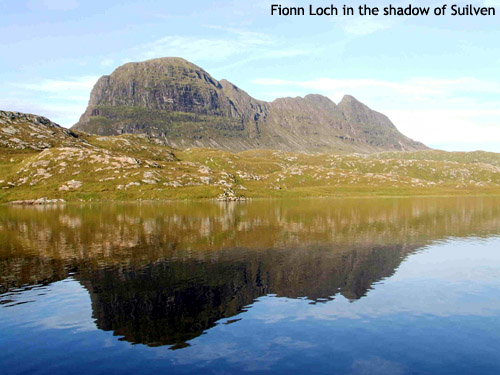
The local hotels proudly display the trophy fish of yesteryear, when catch and release was not vogue as it is now. But there are plenty of big ferox still to be caught plus a huge head of typical, native brown trout. There are also char, sea-trout and salmon to tempt the angler. So, if it’s authentic, wild fishing you fancy, you will certainly get it here.
With only a few boats available on such large waters, you will feel that the whole loch is yours – something you will get used to in Assynt. Angling pressure is light given the plethora of lochs to choose from and if you venture out late season as I do in early September, you may often have a loch completely to yourself…magic! This feeling of freedom alone, in our mad, modern day world, is surely worth the very reasonable price of the permit alone.
It is difficult to comprehend the area of water you will have to fish over in these lochs if you are used to small put and take fisheries or even some of our more modest sized reservoirs. Lochs Assynt, Cam, Veyatie, Bad a Ghaill and Sionascaig are vast and it is often the shear scale of the fishing that can put off visiting anglers. Of course, not all the lochs are large, and if you prefer something more intimate, Assynt has something for everyone. ‘Where do I start?’ is a reasonable enough question and one that is best answered by seeking out a local or two – either in the hotel bar, or by making contact with the Assynt Angling Association through their website. There now also exists an excellent guide to 30 of the popular lochs ‘Trout Fishing in Assynt’ written by Cathel MacLeod. This guide is certainly worth the modest cost as it gives clear guidance on the more productive areas of the lochs.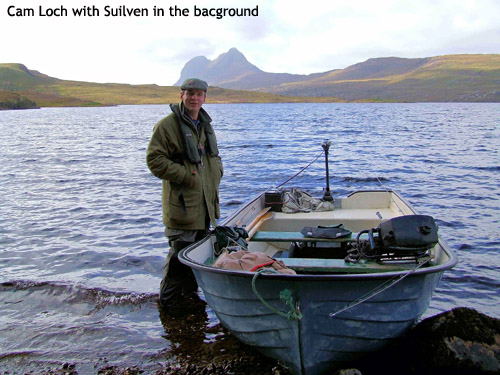
In an effort to bring the fishing to a scale you can get to grips with, it is worth remembering that in the large, deep, glacial lochs, the vast majority of the trout will be close to the margins and to concentrate your efforts there. But it is still not as simple as that, as the composition of the loch bottom has a massive effect on an area’s ability to hold fish and for the casual ‘one visit per year’ angler, it makes sense to seek advice rather than find you have spent the day casting over relatively sterile water.
Being wild fishing and over such large areas of water, do not expect a guaranteed huge basket – you will, more often than not, have to work hard for your fish as the relative number of fish per acre is not high. However the good news is that there are many days where fish do come thick and fast and where baskets of 50 plus fish for a boat do not elicit too many raised eyebrows in the hotel bar.
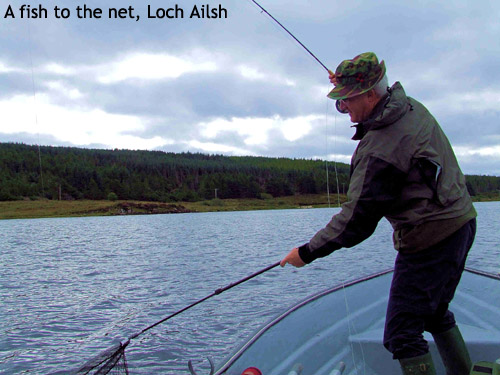 In particular I have found Cam Loch bountiful, having personally had bags of 70 plus fish, and there is huge fun to be had fishing its southern end with a 3-4 weight rod for its prolific number of ¼ - ½ lb fish. They are lightening fast and feisty but would be outgunned by the standard 7 weight outfits likely to be ranged against them. I am also guilty of this as it’s hard to get 11 foot rods any lighter than this, and a long rod really does allow you to control your top dropper which I think can prove decisive in making the difference between a good and a great day. A heavier weight of line can also be useful for when the wind shows its strength, so I always try to have a light (4-5 weight) and a heavy (7 weight) outfit to hand.
In particular I have found Cam Loch bountiful, having personally had bags of 70 plus fish, and there is huge fun to be had fishing its southern end with a 3-4 weight rod for its prolific number of ¼ - ½ lb fish. They are lightening fast and feisty but would be outgunned by the standard 7 weight outfits likely to be ranged against them. I am also guilty of this as it’s hard to get 11 foot rods any lighter than this, and a long rod really does allow you to control your top dropper which I think can prove decisive in making the difference between a good and a great day. A heavier weight of line can also be useful for when the wind shows its strength, so I always try to have a light (4-5 weight) and a heavy (7 weight) outfit to hand.
Generally, I have found loch style to be the most effective method in these parts with a ‘standard’ 3 – wet fly cast, fished on a floating or slow intermediate line likely to serve you well, but do not ignore the dry fly as this can be the method that brings the bigger fish to the boat and I understand this is used by many of the locals as their preferred method. I have heard tales (from reliable sources!) of wonderful fish in the 2-3lb range coming to static sedge and daddy longlegs patterns, and have had a smattering of fish in the 2lb range myself to give credence to such stories.
Something that visiting anglers from more benign parts may struggle with is fly size – it is not unusual to be fishing heavily dressed size 10’s or size 8 flies in a big wave to allow the fish to sight the fly, and medium dressed size 10’s are very effective even in a lighter wind – so do not arrive without these in your fly box or you may regret it. Size 8’s and 10’s will also allow you to possibly tempt a salmon on lochs like Assynt and Awe. Muddler-headed flies with large mobile hackles which cause lots of disturbance have scored well for me in a big wave.
Of all the lochs I have fished in Assynt, Loch Veyatie seems to be the windiest; lying as many of the lochs do in a north-west to south-east orientation, which just happens to funnel the prevailing westerly winds. Last year I twice failed to get out on this loch due to the conditions and had to settle for other more sheltered lochs on the day. Trout fishing is my passion, but no fish is worth dying for. Whilst windy, Veyatie is a wonderful loch to fish and you can easily find yourself on a one-mile drift in the right wind with only the occasional tweak on the electric outboard or oars to keep you fishing in the productive margins. An 11lb trout taken on the fly this summer also still proves that monsters swim in these lochs.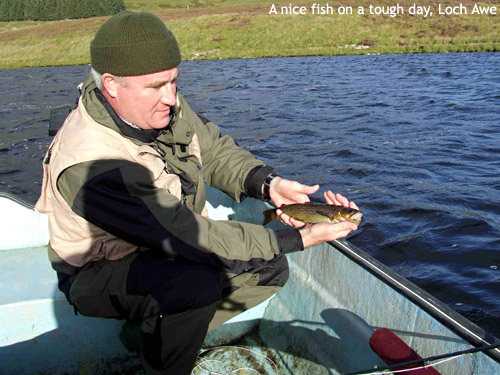
Some further advice in connection with the wind – do not even contemplate fishing these lochs without at least one drogue. Unless an unusually calm day, you will simply spend your time speeding past the trout rather than fishing for them unless you have some means of regulating your speed. For the past 4 years, I have also taken an electric outboard which is wonderful for adjusting a drift to your advantage without using the oars or firing up the noisy petrol outboard. Use the petrol engine for getting you up the loch and use the electric for fine tuning your position.
I seem to be mentioning the wind a lot, don’t I? Well, it is often the deciding factor on the day and you must be prepared to deal with it or you will not enjoy your ‘wild’ fishing as you should. Casting three flies on a windy day with ‘limp’ nylon and with the tight loops promoted by so many contemporary commentators and encouraged by the use of modern fast action rods is a recipe for spending your day in a rage as you repeatedly untangle your cast. How I used to annoy my angling companion by staying tangle free throughout the day as he fought tangle after tangle, threatening to “burn down every fluorocarbon factory he came across…”. The simple fact is that I was sticking to stiffer nylon (as long as there’s a wave, there’s nothing 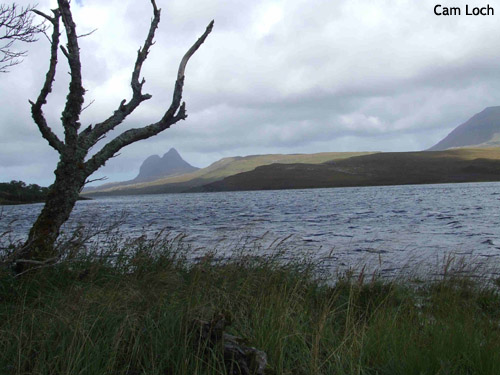 to beat ‘old fashioned’ Maxima) and I have a much more open-looped casting action because I have been brought up fishing wild, windy lochs. Once Sean developed such a casting action, he too stayed tangle free.
to beat ‘old fashioned’ Maxima) and I have a much more open-looped casting action because I have been brought up fishing wild, windy lochs. Once Sean developed such a casting action, he too stayed tangle free.
There is also no need to cast a long line when drift fishing, often the opposite – short ‘searching’ casts being far more productive than fishing out one long cast. Brown trout on these lochs seldom follow a fly, so the trick is to cover as much ‘fresh’ water as you can, in the hope of inducing a take, often just after you have started to move your fly to the boat. With native browns being territorial, it makes sense simply to cover as much territory as possible to maximise your chances. That’s one of the things I so love about fishing these big lochs; there’s so much water to cover you feel that you might be offering your fly to a fish who has never seen anything artificial before…and that the next rise might be from that fish of a lifetime.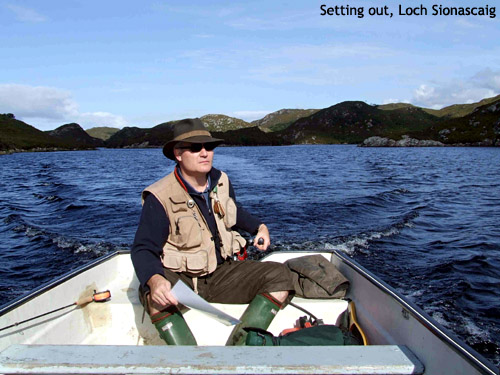
But don’t take my word for it – why not search out ‘fresh’ waters for yourself and sample this wonderful scenery and fishing? True, it’s a long way to travel to the far north-west, but perhaps that can be all part of the adventure…for as Gilbert Chesterton once said “…an inconvenience is only an adventure wrongly considered; an adventure is an inconvenience rightly considered.”
Anthony Glasgow is a lifelong and passionate fisherman, in particular for wild brown trout. Retired from the Royal Engineers as a major in 2004, aged 38 having served in UK, Germany, Canada, Northern Ireland, Bosnia and the Gulf. Now working in Perthshire (where good hillwalking and fishing is but minutes away – coincidence?). Despite his diminutive build, was once considered a good rugby player, but now fishing takes priority whenever he has the time!

